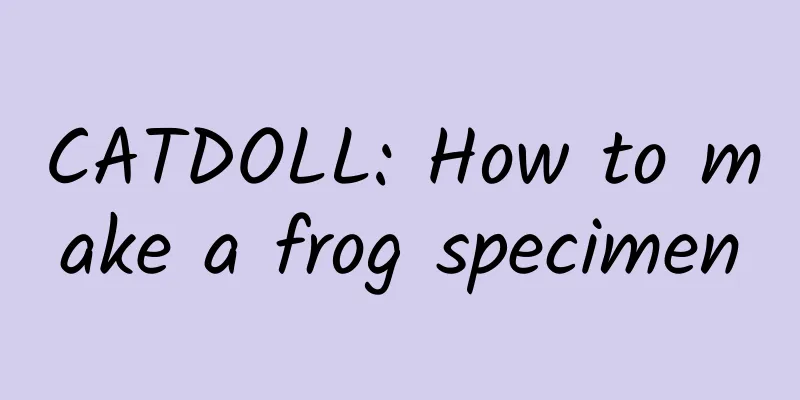CATDOLL : CATDOLL: How to make a frog specimen

How to make a frog specimenBiological specimens are important bases and basic data for studying and exploring the morphological structure and ecological characteristics of organisms. They are authentic in form, complete in structure, and lifelike. They can be preserved forever. Therefore, for a long time, they have not only been used by biologists for scientific research, but also for people to appreciate and collect. They are known as "living relics" and antiques in the history of human development. Some biological specimens of rare animals and plants are facing extinction, and their value can no longer be measured. They have become rare objects for people to study and collect. From the interest in specimen making, students have a strong interest in this. However, when making vertebrate specimens, if the traditional method is used, skin peeling and antiseptic treatment are more difficult for students. For this reason, several improvements can be made. When peeling the skin, the traditional method is to make an incision in the abdomen, first separate the skin and muscles of the hind limbs and tail backwards, then separate the skin and muscles of the forelimbs and head forward to the nostrils, retain the skull, cut off at the foramen magnum, and take the body out of the opening in the abdomen. Because the whole body is large and the opening should not be too large, it is difficult to operate during the peeling process, especially for students, it is easy to break the skin and expand the opening. This will directly affect the suturing of the opening and the beauty of the specimen. Here, we adopt the method of segmented peeling: after making an incision in the abdomen, first separate the skin and muscles of the abdomen and back, and then cut the body from the abdomen into two sections. Then peel forward and backward respectively. This greatly simplifies the operation, especially for larger and longer animals, such as snakes and lizards. In addition, during the embalming process, traditional preservatives are generally prepared with arsenic and some antiseptic drugs, such as; Arsenic (2 parts) + Alum powder (7 parts) + Camphor powder (1 part) + Glycerin (a little) However, arsenic is highly toxic and dangerous to handle, especially for students. Therefore, we can prepare a non-toxic preservative: Boric acid powder (130 parts) + alum powder (7 parts) + camphor powder (60 parts) + glycerin (a little) This preservative has a strong preservative effect, is non-toxic, and is safe to operate. It is suitable for crafts, specimen making, and home furnishings, especially for student specimen making. When students use the above improved method to make specimens, it is easier and safer. At the same time, there are some details in the production, which can be determined according to the production of different specimens. We take the production of bullfrog specimens as an example for specific analysis. First, kill the bullfrog: you can use gas injection or asphyxiation, with asphyxiation being the best method. Then, the exfoliation can be carried out in sections. The limbs are cut off outside the ankle bones, and the toe bones are retained (the muscles on the toe bones should be removed). The head is cut off from the foramen magnum (the muscles on the head should be removed). In addition, the brain tissue in the cranial cavity should be removed (use iron wire to make a curved hook, extend it into the cranial cavity from the foramen magnum, and crush the brain tissue and hook it out). After stripping, do not immediately perform antiseptic and filling. Soak it in 75% alcohol for 1-2 days. Because there is a lot of mucus and grease on the bullfrog's skin, it will be easy to rot in the future. Soaking it in alcohol can remove fat (some amphibians and reptiles such as frogs and lizards can be treated in this way). After 1-2 days, take it out of the alcohol and apply a non-toxic preservative on the inside of the skin (see the preparation method above). Make a bracket with iron wire and put it into the bullfrog to fix it, with the front end fixed at the foramen magnum (make the iron wire into a hook shape and put it into the cranial cavity, and fill the cranial cavity with cotton coated with preservatives, which is conducive to fixation and antiseptic). The iron wire brackets of the limbs pass through the palms for fixation. When filling with cotton, pay attention to filling around the bracket and wrapping the bracket in the middle. Shape the bullfrog while filling it to create its natural shape. Finally, fix the bullfrog on the table and install the eye. An exquisite bullfrog specimen is ready. It can be used for teaching and scientific research, and can also be used for decoration. From the process of making vertebrate specimens, I deeply realized that I must dare to break the tradition, dare to innovate, and find some methods that are easier for students to accept and master, so that they can learn more interestingly and master it easier. How to make dry pot bullfrog?Dry Pot Bullfrog 【Raw Materials】 2 bullfrogs, 5 green peppers, 15-20 cloves of garlic, 5-8 dried red peppers, 2 slices of cinnamon, 1/2 piece of ginger. 【Seasoning】 Blended oil, lard, 3 tablespoons of dark soy sauce, 2 tablespoons of cooking wine, 2 tablespoons of bean paste, pepper, salt, and chicken essence. .【Method】 1. Cut the bullfrog into small pieces and marinate with cooking wine, salt, peppercorns and ginger for 2 hours. 2. Dice the green pepper, cut the dried red pepper into sections and dice the ginger. 3. Pour a medium amount of oil into a cold pan, add 2 tablespoons of lard, add dried pepper sections, ginger, cinnamon, peppercorns and 1/2 amount of garlic cloves. 4. Turn on high heat to fry the seasonings, add the marinated bullfrog pieces and marinade, stir-fry with chili paste, a small amount of salt and dark soy sauce, stir-fry frequently over medium heat, and keep frying for 20-25 minutes. Add the remaining 1/2 garlic cloves halfway, but do not add water. When the bullfrog pieces are basically cooked, add diced green peppers and chicken essence and stir-fry for a few minutes before serving! |
>>: CATDOLL: How to breed guppies How to breed guppies
Recommend
CATDOLL: Who can I sell my cultivated earthworms to (who can I sell my cultivated earthworms to for the most profit)
1. Who should we sell the farmed earthworms to? T...
CATDOLL: What should I do if my tropical fish at home have white spots on their bodies?
Isolate the Ichthyophthirius from the first day o...
CATDOLL: Can I raise it with common duckbill fish? I need help from an expert. It would be best if I could raise fish that can be raised together.
Can I raise it with ordinary duckbill fish? I nee...
CATDOLL: Transmission routes and prevention measures of blue ear disease in pigs
What is blue ear disease? Blue ear disease, also ...
CATDOLL: Is eel hot or cold? Is eel a fish?
Is eel hot or cold? Is eel a fish? Eel is a delic...
Cats don’t love their owners, they only love their own kind. Is this true?
Cats love their owners and their own kind. Althou...
CATDOLL: How many silk quilts can be produced from raising silkworms on one acre of land?
1. How many cotton bags can be made from one poun...
CATDOLL: What can I feed soft-shelled turtles?
1. What can I feed soft-shelled turtles? If it is...
CATDOLL: When does silkworm rearing start? (When does silkworm rearing start?)
1. Which month is it best to raise silkworms? Mar...
CATDOLL: The truth about hormone-fed pigs: a comprehensive analysis from breeding to nutrition
introduction As people pay more and more attentio...
CATDOLL: Can angelfish be raised together with peacocks and other fish?
1. Can angelfish be raised together with peacocks...
CATDOLL: Is the Stardew Valley sea urchin useful?
1. Is the Stardew Valley sea urchin useful? Sea u...
CATDOLL: How to calculate the cost of mealworm breeding and operation?
1. How to calculate the cost of mealworm breeding...
CATDOLL: What do flies eat to survive?
1. Do flies prefer sweet or salty food? Because f...
CATDOLL: What are the reasons for having ants at home (how to completely eliminate ants at home)
1. Why are there so many ants at home? There may ...









